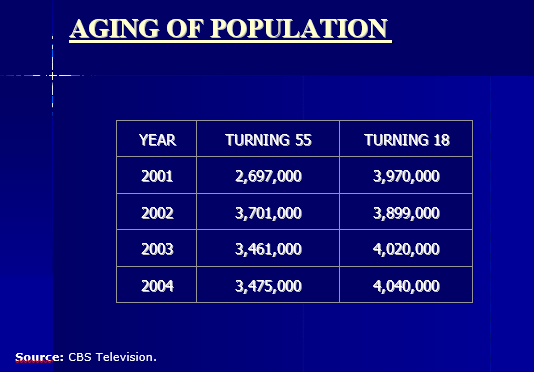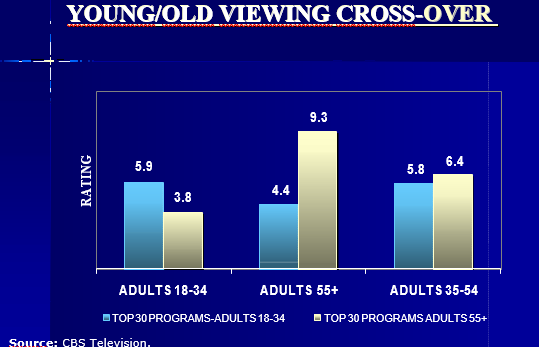Classic Jack: Turning 55 Years Old and the Suddenly Relevant Poltrack Doctrines

Originally published October 30, 2002. I recently celebrated my 55th birthday. I use the word 'celebrated' advisedly. This is the first birthday that has mentally challenged me. Twenty-five was a positive milestone. Thirty, Forty and Fifty were all acceptable because, being in the media business, I justified to myself that I remained within the boundaries of marketing desirability and demand. But now I am no longer 25-54. I have, with the passage of one day, transferred from youthful cohabitation with 25-year-olds, to the never-never land of 55 plus. In the minds of advertising media buyers, I have become old and irrelevant. Of course, I still feel young; in fact, younger than ever.
I have no predisposition against the younger 18-34 audience segment. In fact, I recently published a counter-point to a New York Times Magazine column that had attacked the integrity of marketers and media buyers who focus their ad budgets on reaching younger audiences at the expense of us older folks. I remain comfortable with the points I made disputing the credibility of the NY Times piece. As I read that piece, though, I was bewildered why the author made no effort to reach out to CBS' David Poltrack, who has been the most outspoken advocate of marketing to the 45+ market. For at least 20 years, David has been in the forefront of promoting the viewpoints of "Age Wave" author Ken Dychtwald. Poltrack's research has become the industry standard for advancing the value of 45+ and 55+ audiences. Of course, Poltrack's doctrines are self-serving, since he represents CBS, which has for years been punished by media buyers for its heavy weight of 55+ audiences.
According to Poltrack, his reports and commentaries of past years are taking on greater urgency and importance. "We have reached a critical marketing juncture," he said in a recent presentation at the Mature Market Summit. "Up until now, the marketer could feel somewhat comfortable with a broad-based target of 18-49 or 25-54 since the composition of that segment was relatively stable." This reality has now changed, says Poltrack, because the two fastest growing segments of the population are at the older and the younger extremes, with the younger 18- 24 audience growing at the fastest rate. "If a marketer decides not to change his or her age-based target from its current 18-49 or 25-54 base, that marketer is, in fact, changing the emphasis of the marketing program. The emphasis is shifting from adults in the older range of that age span to adults in the younger range of that age span."

Poltrack acknowledges: "It may be that for certain products or services, given the size of the new 18-24 segment, a shift in emphasis towards the younger edge of the 18-54 age span is warranted. However, I would argue that for most products or services sold today, a targeting approach that does not assign some significance to the large and growing market of adults in their fifties, is misguided."
Youth Targeted Television Is Not the Most Efficient
"Contrary to the common belief that the younger skewing programs will deliver the older audience much more effectively than the older skewing programs will deliver the young audience, we see that the older skewing programs' delivery of young adults is not much lower than the younger skewing programs' delivery of older viewers. And the Top 30 programs with Adults 55+ deliver a higher rating among the key, middle-aged, Adults 35-54."
Brand Loyalty Does Not Exist, says Poltrack
Another myth that Poltrack seeks to dispel suggests that younger audiences are more valuable because of their increased propensity to try new brands and the lifetime value they bring to the brands to which they develop loyalties. "The fact is that brand loyalty doesn't really exist today," claims Poltrack. "In a study done for us [CBS] by A.C. Nielsen in 1993, brand switching was measured in thirty-one different packaged goods categories. Approximately two-thirds of the purchases made by Adults 18-34 were made to a brand that was not the most often purchased brand. For Adults 35-64 that figure is higher, seventy percent. In other words, no one is very brand loyal, and the younger consumers are morebrand loyal than older consumers."
The results of this research have been summarized in a series of papers that Poltrack has written with Henry Assael of NYU. These articles, which have been published in the Journal of Advertising Research, prove that age is a poor surrogate for product usage in most product categories; that combining age with another demographic provides a much better fit with actual product usage; and that direct product usage provides the best source of media evaluation.

Are Changes on the Horizon?
According to Poltrack, "Over the ten- year span that we have published these articles no one has challenged the findings or presented any supporting evidence for the validity of the current age-based media evaluation. Yet, media buying and selling continues to be based on the same Adult 18-49, Adult 25-54 and Adult 18-34 criteria as they were in the 1970s. One reason for this lack of progress towards a better media evaluation system has been the lack of a reliable method of integrating product usage data and other meaningful advertising data with media audience data." Poltrack believes that, for the first time, there are promising new attempts at this integration. He offers as examples Simmons' new Behaviorgraphics approach that combines usage data from other sources with the basic Nielsen NTI data; Next Generation Research's Advertising Receptivity Report, which measures media audiences in terms of both product usage and receptivity to advertising for various products and services; and a variety of experiments with fusion techniques.
Poltrack continues to believe that "the current state of media evaluation and advertising targeting is dominated by a fundamentally flawed, and increasingly anachronistic, age-based process. This process is resulting in the misallocation of billions of dollars in media expenditures and in an imbalance in the programming mix of the media." He believes that "the combination of marketers' increasing realization that the important baby-boomer market is disappearing from their radar screens and the introduction of new media evaluation systems may finally be turning the tide."
Until my recent 55th birthday, I really didn't care very much about this issue. I have suddenly become a believer.
Click the social buttons above or below to share this story with your friends and colleagues.
The opinions and points of view expressed in this content are exclusively the views of the author and/or subject(s) and do not necessarily represent the views of MediaVillage.com/MyersBizNet, Inc. management or associated writers.


